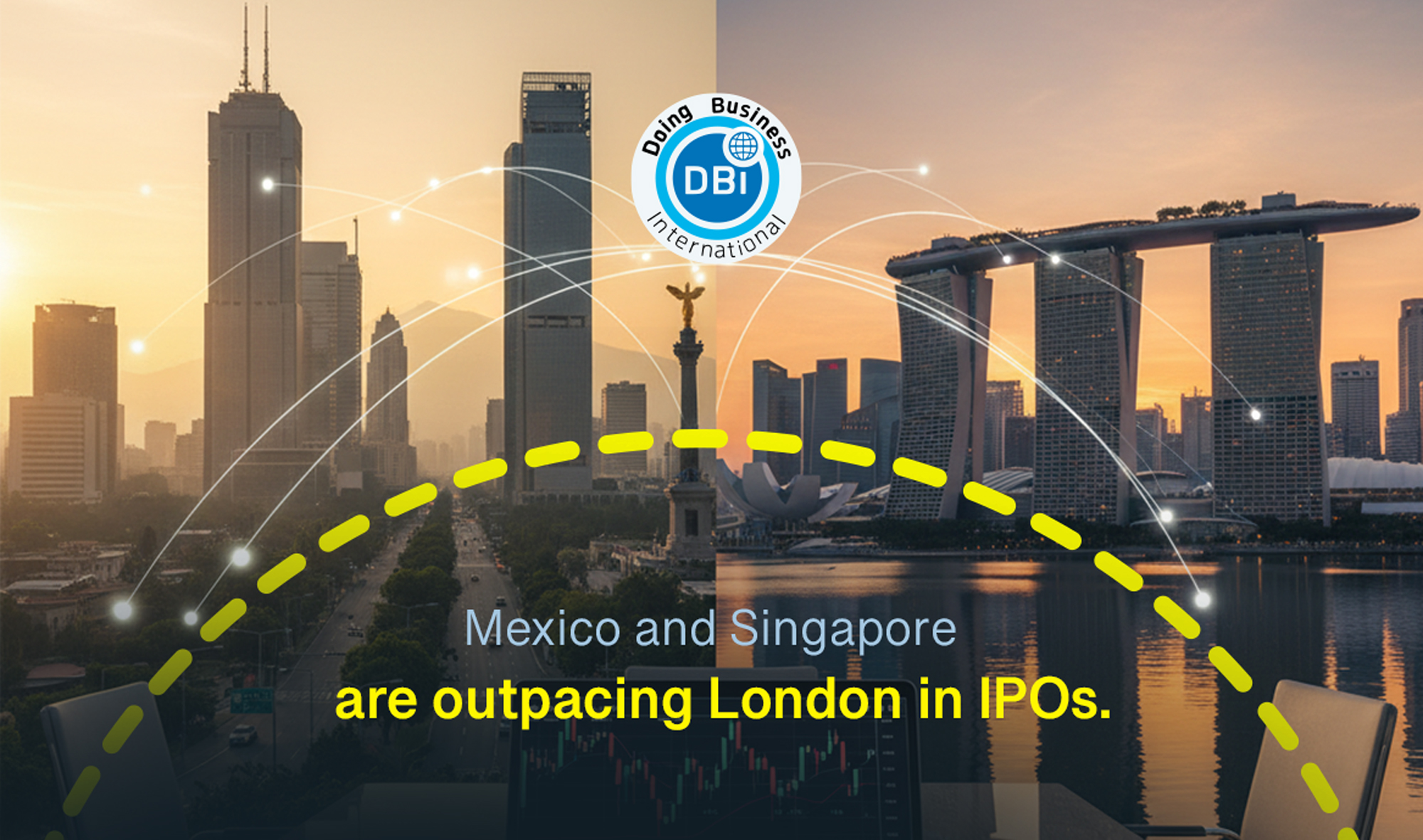
Are Mexico and Singapore Leaving London Behind in the IPO Race, What Should Corporates Do About It?
By Doing Business International | October 8, 2025
London’s long-standing position as a premier global IPO hub is under increasing strain.
Over the past 18 months, Mexico and Singapore have quietly gained momentum, recording stronger pipelines and faster execution for mid-cap and growth listings.
This isn’t simply cyclical, it’s structural.
Three converging forces are reshaping the global IPO landscape:
1. North American nearshoring and supply chain realignment,
2. Regulatory agility and faster time-to-market,
3. The rise of regional capital that prefers proximity and predictable liquidity over prestige.
What’s Changing
1. Nearshoring and Supply Chains
Mexico is at the epicenter of a once-in-a-generation industrial shift. With over US$110 billion in announced foreign direct investment (FDI) in 2024 (Source: Mexico’s Ministry of Economy, 2025), the country is capturing advanced manufacturing and Tier 1–3 suppliers relocating from Asia to serve the North American market.
Public listings are following production footprints. For many firms, especially in automotive, electronics, and logistics, listing closer to operations and investors in Mexico reduces both friction and funding costs.
In 2024, the Mexican Stock Exchange (BMV) and BIVA saw eight IPOs, the highest number since 2017, led by energy, logistics, and fintech firms. In contrast, the London Stock Exchange (LSE) recorded just 18 IPOs, its lowest in over a decade, with total proceeds down 35% year-on-year (Source: EY Global IPO Trends Q1 2025).
2. Regulatory Agility
Singapore’s Monetary Authority (MAS) and the Singapore Exchange (SGX) have streamlined their IPO pipeline, reducing average time-to-market from 12 months to roughly 7 months, with clear disclosure and ESG frameworks.
Similarly, Mexico’s regulators, CNBV and BMV, have accelerated pre-filing review cycles, allowing qualified corporations to go public within 6–9 months, depending on sector and capitalization.
By contrast, London’s regulatory process has grown more complex following Brexit-era fragmentation and changing investor appetite. As of 2025, average LSE listing costs are estimated 25–30% higher than in Singapore or Mexico (Source: PwC Capital Markets Review 2025).
3. Regional Capital Flows
Both Mexico and Singapore benefit from regionally anchored capital pools.
• In Mexico, Afores (pension funds) now manage over US$300 billion and are increasingly allowed to participate in equity placements.
• In Singapore, sovereign and family-office capital (Temasek, GIC, and regional family groups) actively anchor IPO allocations, ensuring liquidity and stable aftermarket support.
This local capital orientation creates faster book-building, tighter pricing, and less volatility, attributes many issuers value over the prestige of a London listing.
Implications for Corporates
• Listing Strategy
For companies whose business models are regionally anchored—manufacturing, logistics, tech, or energy, primary listings in Mexico or Singapore can better align with operational and investor realities. Dual listings (LSE or Nasdaq) can remain optional for global liquidity or sector visibility.
• Market Readiness
Corporates must invest early in local investor education, sell-side research coverage, and ESG alignment with venue standards. The more transparent the equity story, the faster the regulatory green light.
• Governance Alignment
Both SGX and CNBV prioritize board independence, disclosure consistency, and free-float thresholds. Firms that preemptively structure governance to these standards often shorten approval timelines.
Implications for Banks and Advisors
• Investment Banking
Strengthen on-the-ground coverage teams in Mexico City and Singapore. Execution agility, underwriting, distribution, and cross-border structuring, is becoming a differentiator.
• Syndicate Strategy
Broaden anchor investor networks. Regional family offices and pension funds now play the role London institutional investors once dominated. Balancing retail and institutional tranches ensures post-listing liquidity.
• Post-Listing Execution
Success no longer ends at the IPO. Active market-making, consistent IR engagement, and coverage maintenance are critical to protecting valuation multiples and sustaining demand.
Quick Venue Checklist
✅ Is the growth story tied to T-MEC/USMCA nearshoring or APAC supply chains?
✅ Where does your natural investor base reside?
✅ Can the venue deliver a predictable 6–9 month approval timeline?
✅ How do total listing costs (fees, compliance, advisory) compare to expected liquidity?
Risks to Manage
• Mexico: Market depth can vary by sector; liquidity is improving but still concentrated in top issuers.
• Singapore: Governance and disclosure standards are stringent; preparation must be detailed.
• Cross-venue risk: FX volatility and valuation differentials between local and global benchmarks require careful arbitrage management.
Conclusion
The global IPO landscape is becoming multipolar.
As Mexico and Singapore outpace London in listings and investor traction, corporates and advisors must align their capital-raising strategies with operational realities and investor geography.
For many issuers, these aren’t alternative venues, they’re the natural markets to list, fund, and scale in a rapidly regionalizing global economy.
📊 Sources:
• EY Global IPO Trends Q1 2025
• PwC Capital Markets Review 2025
• Reuters (April 2025): Mexico IPO Pipeline Expands on Nearshoring Boom
• Monetary Authority of Singapore, 2025
• Mexico Ministry of Economy (SE), 2025
Latest Articles
-
Open iGaming Bank Account 2026: High-Risk Merchant & Corporate Banking Guide
December 1, 2025
-
How to Open a Bank Account in the United Kingdom: 2025 Guide
November 28, 2025
-
Navigating Global Wealth Trends with HSBC Expat Wealth Insights 2025
November 24, 2025
-
Denmark, Tokenization, and Leadership: DiGi Shares Pioneering Europe’s Digital Asset Revolution
November 17, 2025
-
Is Spain Your Next Business HQ in 2025, How Do You Open a Company There?
November 14, 2025